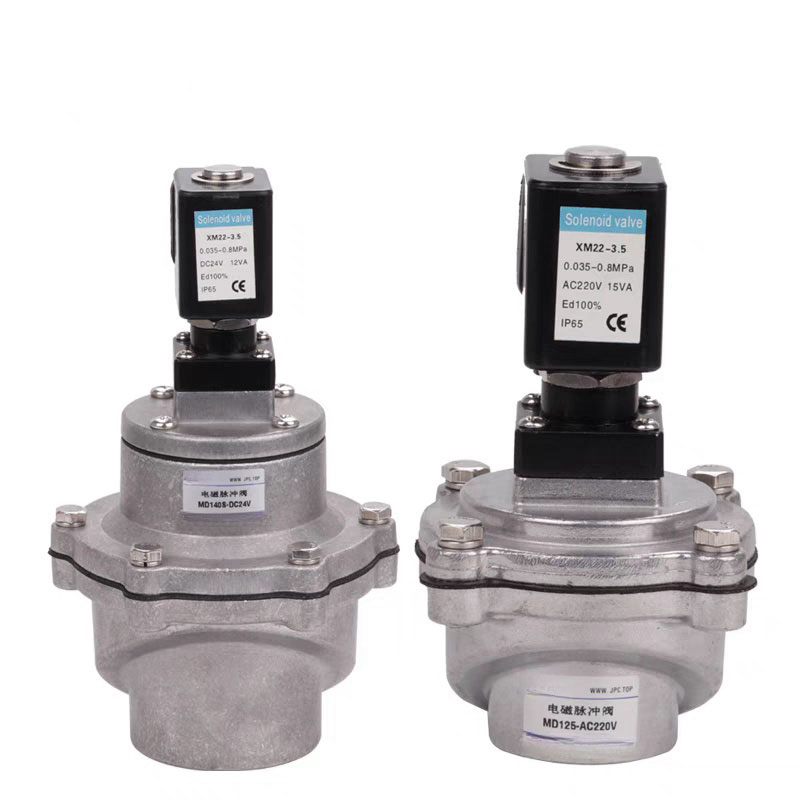Common Issues with Pulse Valves and Their Solutions
2024-12-19
Pulse valves are critical components in dust collection systems, typically used in industrial settings to regulate the flow of compressed air for cleaning filters. When they fail or don’t operate correctly, it can lead to inefficiencies, increased energy costs, and even system breakdowns. Understanding common issues with pulse valves and how to address them can help ensure smooth operation and extend the life of the valve and the overall system.
Here are some of the most common issues with pulse valves, along with their possible solutions:

1. Valve Fails to Open or Close
Cause:
- Faulty Solenoid Valve: The solenoid may not be sending the correct signals to the pulse valve.
- Air Supply Issues: Insufficient or inconsistent compressed air pressure can prevent the valve from functioning properly.
- Sticking Components: The valve’s diaphragm, spring, or other components may be stuck due to dirt or debris.
Solution:
- Check Solenoid Valve: Test the solenoid with a multimeter to ensure it is receiving the correct voltage and is functioning properly. Replace if necessary.
- Inspect Air Pressure: Ensure that the system is providing adequate and consistent compressed air pressure. If not, adjust the regulator or repair air supply issues.
- Clean the Valve: Disassemble the pulse valve, clean it thoroughly, and inspect for any dirt or debris blocking the diaphragm or valve seats. Lubricate as required (with the correct lubricant for the valve type).
2. Inconsistent or Weak Pulse
Cause:
- Low Air Pressure: Insufficient compressed air pressure results in weak or inconsistent pulses.
- Incorrect Valve Settings: Improper valve timing or pulse duration settings may be causing the pulses to be too short or weak.
- Blocked Pilot Valve: The pilot valve controlling the pulse may be clogged or malfunctioning.
Solution:
- Increase Air Pressure: Ensure that the system is providing enough air pressure for the pulse valve to perform optimally. Check for leaks in the system that may cause pressure drops.
- Adjust Pulse Settings: Refer to the manufacturer’s guidelines for the correct pulse duration and interval settings. Adjust the timing settings to suit your application.
- Clean or Replace Pilot Valve: Inspect the pilot valve for dirt, corrosion, or malfunction and clean or replace as necessary. A blocked pilot valve can impede air flow and lead to weak pulses.
3. Valve Leaks Air
Cause:
- Worn Seals or Gaskets: Over time, the seals or gaskets in the valve can wear out, leading to air leakage.
- Damaged Diaphragm: If the diaphragm is cracked or punctured, air can leak from the valve.
- Improper Assembly: Incorrect assembly or misalignment of the valve components can cause leaks.
Solution:
- Inspect Seals and Gaskets: Examine the seals and gaskets for wear or damage. Replace any parts that are worn or cracked.
- Check the Diaphragm: Inspect the diaphragm for signs of wear, cracks, or punctures. If damaged, replace the diaphragm with a new one that is compatible with your pulse valve model.
- Reassemble Correctly: Ensure that the valve is assembled correctly, and all components are aligned properly to avoid air leakage. Tighten any loose connections and check for leaks after reassembly.
4. Pulse Valve is Making Excessive Noise
Cause:
- Improper Air Pressure: Too much air pressure can cause the valve to operate too forcefully, creating excess noise.
- Faulty Valve Components: Worn-out or damaged parts inside the valve, such as the diaphragm or valve seat, can create noisy operation.
- Loose Mounting or Connections: If the valve or its components are not securely mounted, vibrations during operation can lead to noisy performance.
Solution:
- Check Air Pressure: Ensure that the air pressure is within the recommended range for the valve and system. Adjust the regulator if necessary.
- Inspect for Damage: Examine internal parts such as the diaphragm, valve seat, and springs for damage or wear. Replace damaged components to restore proper function.
- Tighten Connections: Ensure that all mounting bolts, screws, and connections are tight and secure. Use vibration-damping materials if necessary to reduce noise caused by vibration.
5. Valve Is Not Responding to Control Signals
Cause:
- Electrical Issues: If the valve is controlled electronically, issues with wiring, solenoid, or control system can prevent the pulse valve from responding.
- Faulty Control Circuit: Problems in the control circuit, such as incorrect wiring or malfunctioning sensors, can cause the valve to fail to operate.
- Valve Coil Burnout: If the coil of the solenoid is burned out or damaged, it may not activate the valve.
Solution:
- Check Electrical Connections: Inspect all electrical connections, wires, and terminals for damage, wear, or loose connections. Repair any issues as needed.
- Test the Solenoid Coil: Measure the solenoid coil’s resistance with a multimeter to check for proper functionality. Replace a faulty solenoid coil.
- Inspect Control Circuit: Test the control circuit for any malfunctions. Replace any faulty components in the circuit, such as sensors or relays.
6. Valve Cycles Too Frequently
Cause:
- Improper Timing Settings: The pulse valve’s cycle time or interval may be set too short.
- Faulty Timer or Controller: A malfunction in the timer or controller circuit could cause the valve to cycle too often.
- Dirt or Blockages in the Valve: Dirt or blockages inside the valve can cause irregular valve operation, leading to excessive cycling.
Solution:
- Adjust the Timer Settings: Check the timing settings on the controller. The pulse frequency and timing should match the needs of the system. Adjust the cycle time to the recommended settings.
- Inspect and Clean the Valve: Disassemble the valve and remove any dirt, dust, or debris that could be affecting its operation. Clean all parts carefully and reassemble the valve.
- Test the Control System: Verify that the timer or controller is functioning properly. If the control system is faulty, replace or repair it.
7. Valve Failure Due to Excessive Wear
Cause:
- High Operating Pressure: Continuous operation at high pressure can cause accelerated wear of internal components, including diaphragms, seals, and springs.
- Improper Maintenance: Lack of regular maintenance, such as cleaning and inspection, can lead to premature wear.
- Excessive Cycling: Over-cycling of the pulse valve (when the valve opens and closes too frequently) can lead to early wear and failure.
Solution:
- Monitor Operating Pressure: Ensure the system operates within the recommended pressure range to avoid undue stress on the valve. If necessary, install pressure regulators or relief valves to maintain safe pressure.
- Schedule Regular Maintenance: Implement a routine maintenance schedule to clean, inspect, and replace worn-out parts like diaphragms and seals.
- Optimize Cycling Frequency: Ensure that the pulse valve is not being cycled too frequently. Proper system design and configuration can help minimize unnecessary cycles.
Conclusion
Pulse valves are essential for dust collection systems and other industrial applications, but they can face a variety of issues over time. By understanding the common problems and implementing the right solutions, you can improve the reliability and longevity of the valve, reduce downtime, and ensure your system operates efficiently. Regular maintenance, timely repairs, and proper calibration are key to preventing these issues from arising and ensuring smooth, uninterrupted operation.


